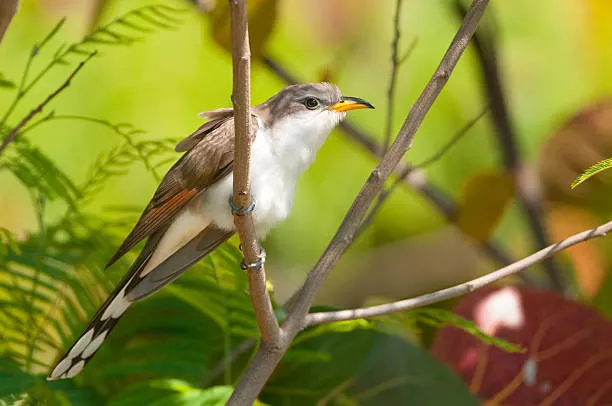Within the realm of avian wonders, the Yellow-Billed Cuckoo (Coccyzus americanus) stands out as a captivating and enigmatic species. Known for its distinct appearance, intriguing behavior, and remarkable migratory patterns, the Yellow-Billed Cuckoo is a bird that ignites curiosity among bird enthusiasts and nature lovers. In this article, we will explore the key features, habitat preferences, behavior, and conservation status of this unique cuckoo species.
Physical Characteristics:
The Yellow-Billed Cuckoo is a medium-sized bird with a slender body, measuring approximately 28-30 centimeters in length. It has a long tail, which serves as a distinguishing feature, extending beyond the wingtips when in flight. Here are the key physical characteristics of the Yellow-Billed Cuckoo:
Plumage: The bird’s overall plumage is predominantly brown, providing excellent camouflage within its habitat. Its underparts are white, while the upperparts showcase shades of brown, blending harmoniously with the surrounding foliage. The wings exhibit a mottled appearance, featuring intricate patterns of black, white, and brown.
Bill: As its name suggests, the Yellow-Billed Cuckoo possesses a vibrant yellow bill. The bill is relatively long, slender, and slightly curved, facilitating its feeding habits and allowing it to snatch insects and caterpillars with precision.
Habitat and Distribution:
The Yellow-Billed Cuckoo can be found in a range of habitats across North and Central America during its breeding season. These include:
Riparian Woodlands: The cuckoo shows a preference for riparian habitats, such as riverbanks, stream corridors, and wooded wetlands. These areas provide the bird with an abundance of caterpillars, insects, and spiders, which constitute its primary diet.
Forested Areas: The Yellow-Billed Cuckoo is also found in open woodlands, deciduous forests, and scrublands. It seeks out dense vegetation with a mixture of trees and shrubs, offering suitable nesting sites and ample foraging opportunities.
Migration:
The Yellow-Billed Cuckoo is renowned for its remarkable migratory behavior. It undertakes extensive journeys, traveling thousands of kilometers each year between its breeding and wintering grounds. Key aspects of their migration include:
Breeding Season: During the breeding season, Yellow-Billed Cuckoos can be found across North and Central America, including regions of the United States, Canada, Mexico, and the Caribbean. They arrive in their breeding grounds during spring, typically from April to May.
Wintering Grounds: In the winter, the Yellow-Billed Cuckoo migrates to regions of Central and South America. It can be found in countries such as Costa Rica, Panama, Colombia, Venezuela, and Ecuador, where it seeks out suitable habitats for feeding and resting.
Behavior and Feeding Habits:
The Yellow-Billed Cuckoo is known for its secretive and elusive behavior. Here are some notable behavioral traits:
Foraging: The cuckoo is an adept and agile insect hunter. It has a particular fondness for caterpillars, which constitute a significant portion of its diet. The bird often snatches prey from vegetation using its long bill, and it can even feed on wasps, bees, and other flying insects.
Nesting and Parental Care: Yellow-Billed Cuckoos build shallow cup-shaped nests using twigs, grass, and plant fibers, typically located in the dense foliage of shrubs or trees. The female cuckoo lays eggs, and both parents take turns incubating them. After hatching, the parents care for the young, providing food and protection until they fledge.
Conservation Status:
The Yellow-Billed Cuckoo faces several conservation challenges due to habitat loss, degradation of riparian zones, and the reduction of suitable breeding grounds. Despite these threats, conservation efforts are being undertaken to protect its habitat and promote awareness of its ecological significance.
Conclusion:
The Yellow-Billed Cuckoo stands as a remarkable bird within the avian world, with its distinctive appearance, habitat preferences, migratory journeys, and unique feeding habits. Appreciating the fascinating characteristics and behaviors of this species allows us to recognize the importance of preserving their habitats and ensuring their continued presence in the natural ecosystems they call home.


 Facebook
Facebook  Instagram
Instagram  Youtube
Youtube 